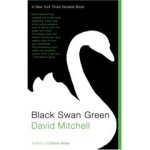In works ranging from ghostwritten to Cloud Atlas, David Mitchell has shown that he’s a fearless and an eminently capable writer. His formal inventiveness and experimentation with styles, points of view, and non-linear plot structures yields a richly conceptual fiction.
 In Black Swan Green, however, Mitchell eschews post-modern pyrotechnics in favor of a simple narrative style. Set in the village of Black Swan Green in Worcestershire, England in the early 1980s, we follow a year in the life of Jason Taylor, 13-year old English chap, who suffers from a stammer he calls Hangman and writes poetry under the nom de plume Eliot Bolivar. Like many adolescents, Jason struggles with mortality, adult hypocrisy, and the pain of being different.
In Black Swan Green, however, Mitchell eschews post-modern pyrotechnics in favor of a simple narrative style. Set in the village of Black Swan Green in Worcestershire, England in the early 1980s, we follow a year in the life of Jason Taylor, 13-year old English chap, who suffers from a stammer he calls Hangman and writes poetry under the nom de plume Eliot Bolivar. Like many adolescents, Jason struggles with mortality, adult hypocrisy, and the pain of being different.
This narrative change of pace is a refreshing departure for Mitchell. You’ll almost look in vain for physical descriptions, for instance, in Cloud Atlas, where, if you are as vigilant as a bird of prey, you might notice that Rufus Sixsmith wears a gabardine coat. Like Saramago, with whom he otherwise has little in common, Mitchell has a tendency to soar off the page into abstract realms. But with Black Swan Green, he plunges headlong into the bright, redolent world of sensory details.
Jason’s sister’s boyfriend, for instance, has … “exploding red hair, sooty freckles, and a bouncy walk. He wore a peach shirt under a baggy indigo sweater, black drainpipes, one of those studded belts that sags loose off your hips, and winkle-pickers with white tube socks…” Luscious mangoes taste like “perfumed peaches, bruised roses” and beef “like deep-sea phlegm,” and the kitchen smells of “lavender and bacon rinds.”
As the vibrant world of Black Swan Green unfolds, we learn that Jason is a verbifyer extraordinaire—”chuntering,” “clackering,” and “snaffling,” as well as “juddering,” “knackering,” and “elasticking”—who, in true Mitchellian fashion, is also profoundly sensitive to the great incongruities of the world:
I dip my fountain pen into a pot of ink, and a Wessex helicopter crashes into a glacier on South Georgia. I line up my protractor on an angle in my Maths book and a Sidewinder missile locks onto a Mirage III. I draw a circle with my compass and a Welsh Guard stands up in a patch of burning gorse and gets a bullet through the eye.
Mitchell’s novel is bursting with cinematographic scenes. Like the time when Jason is injured and finds himself in the foreboding House in the Woods, being tended to by an old, mysterious woman who is haunted by the memory of her dead brother. Or the almost-kiss with tomboy Dawn Madden who has eyes of dark honey and a throat of white chocolate.
But my favorite scene is Jason’s mad dash through neighborhood backyards to gain membership into a secret society called Spooks. He clambers over a fence, sprints through an abandoned yard overgrown with weeds, then an even dodgier lot with two fat ladies watching TV, then Mr. Broadwas’ yard with the sprinklers swsss-swwss-swwwsssing away, then “a concrete meringue” with ornaments, gravel, and gnomes, then a tight-rope walk across a 10-foot high fence hovering over a greenhouse, and finally through a backyard adorned with a trellis of roses and a family playing Twister in their cottage. The scene combines the adventure of childhood with the magic of prose fiction.
After all, storytelling is a virtual romp through distant or neighboring yards.

Nice post, Kevin
I think sums up a lot of what is best about “Black Swan Green” — which I agree is a nice departure from the usual Mitchell tropes (although I enjoy those very much, as well). “Black Swan Green” is the kind of coming of age novel you could imagine supplanting “The Catcher in the Rye” for a new generation. All the abounding insecurity felt by Jason Taylor is timeless and eminently relatable to anyone who has ever been an adolescent.
Very English and instantly recognisable. I was a champion hedge-hopper in my day 😉